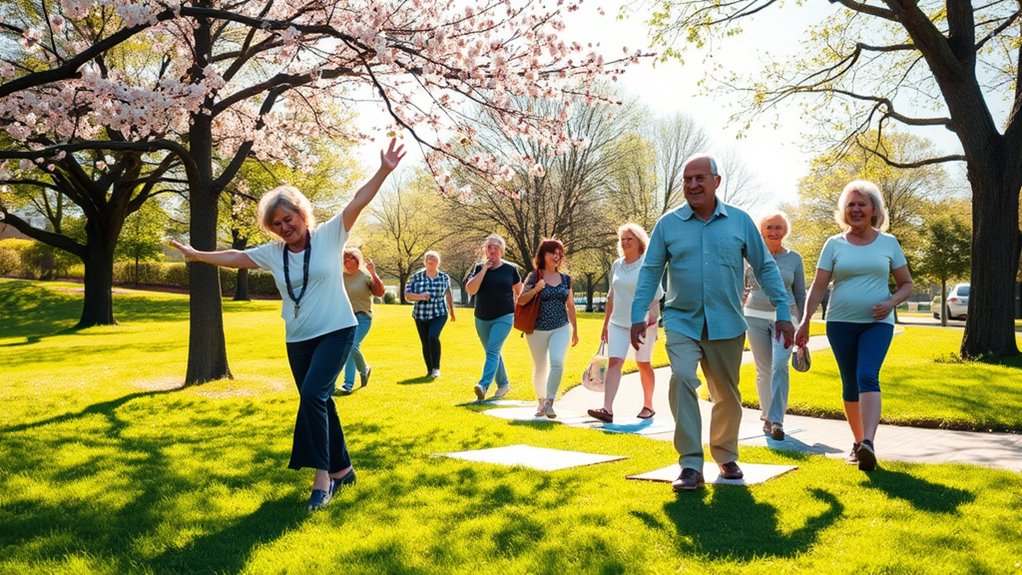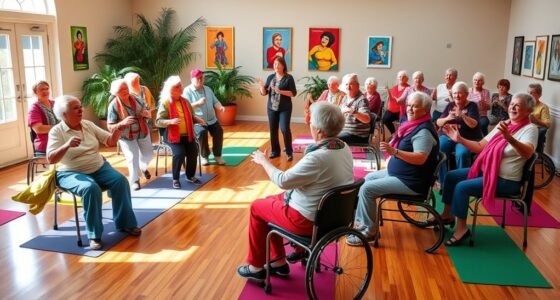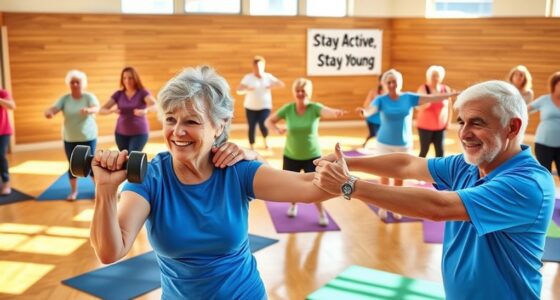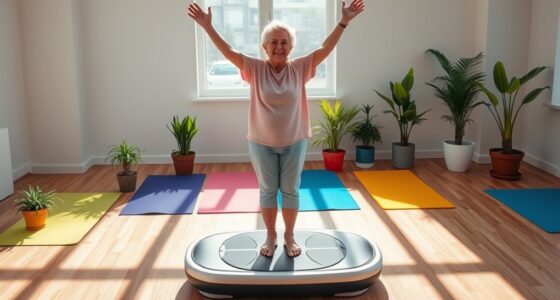Staying active as a senior is essential for your health. Aim for 150 minutes of moderate activity each week, like walking or swimming, plus strength training twice weekly. Simple exercises like wall push-ups or light cleaning can fit right into your daily routine. To keep consistent, set achievable goals and consider joining group classes for motivation. Engaging in activities that you enjoy can make a world of difference in your well-being, and there’s more to discover!
Key Takeaways
- Aim for at least 150 minutes of moderate-intensity activities per week, like walking or swimming, to stay active and healthy.
- Incorporate strength training exercises twice a week to support muscle strength and prevent falls.
- Engage in balance exercises, such as tai chi, to enhance stability and reduce fall risk.
- Include light daily activities, like cleaning or slow walking, to maintain movement and flexibility.
- Start with short sessions of 10-15 minutes and gradually increase duration to build consistency in your routine.
The Importance of Staying Active for Seniors
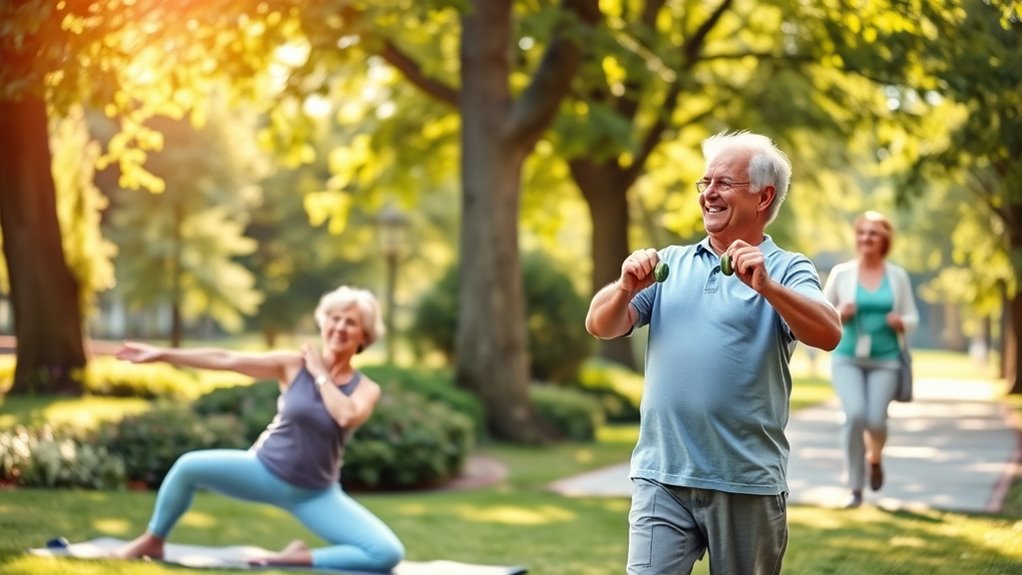
Staying active is essential for seniors, not just for physical health but also for mental well-being. Engaging in regular physical activity can greatly reduce your risk of chronic diseases like heart disease and diabetes, which become more common as you age. Additionally, young players are increasingly recognized for their remarkable potential in sports, serving as an inspiration to maintain an active lifestyle. Regular exercise can also help you reset, recover, and restart your mental health, enhancing your overall quality of life. Physical activity promotes emotional and psychological growth which is essential for maintaining a positive outlook as you age.
Maintaining muscle strength and bone density is important for preventing falls, a serious concern for many older adults. Furthermore, exercise boosts your mental health by alleviating anxiety and depression, enhancing your cognitive function, and lowering the risk of cognitive decline associated with dementia.
Maintaining muscle strength and bone density is vital for fall prevention and enhancing mental health in older adults.
Staying active also supports your immune system, helping you fend off infections. Plus, group activities foster social connections, offering a sense of community that’s crucial for emotional well-being. Additionally, incorporating regular health screenings can help identify potential health issues early on, ensuring you stay on track with your fitness goals.
Prioritizing physical activity truly enriches your life.
Benefits of Regular Exercise
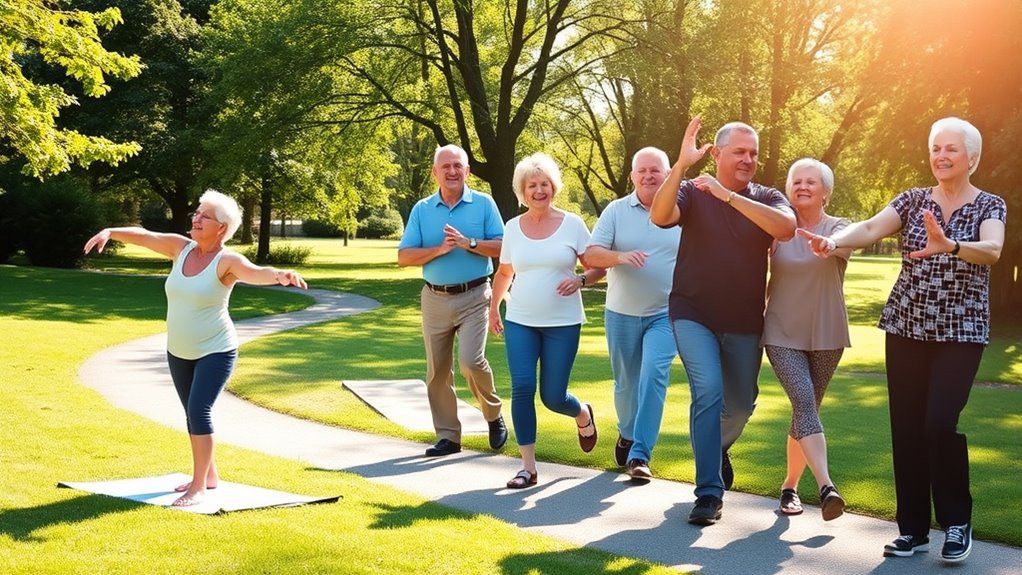
Regular exercise offers you a wealth of benefits that can transform your physical and mental health. It can greatly reduce your risk of heart disease and stroke while also boosting your mood and cognitive function. Additionally, incorporating nutrient-rich foods like chia seeds can further enhance your overall health and support your exercise routine. Physical activity can also help enhance sleep quality and combat feelings of fatigue. Engaging in regular exercise is essential for cardiovascular health and can significantly improve your overall well-being. Eating a balanced diet with high-protein breakfasts can provide the energy needed to sustain an active lifestyle. Moreover, including omega-3 fatty acids from chia seeds can improve heart health and support recovery after workouts.
Physical Health Improvements
As you embrace regular exercise, you’ll notice significant improvements in your physical health. Engaging in just 150 minutes of moderate-intensity activity each week can dramatically lower your risks of chronic diseases like heart disease, stroke, and diabetes. Additionally, creating transforming spaces that encourage movement can greatly enhance your motivation to stay active. Regular exercise can also align with the Law of Attraction principles to enhance your overall mindset and emotional well-being.
It also strengthens your muscles and bones, which is essential in reducing the risk of osteoporosis and falls—concerns that affect 1 in 4 older adults annually. Regular exercise boosts your immune function, helping you fend off illnesses, especially important as you age. In fact, long-term financial planning for health-related expenses can ease the burden of managing chronic conditions as you grow older. Furthermore, incorporating classical music into your exercise routine can enhance cognitive function and improve overall motivation for physical activity.
Plus, it enhances sleep quality, addressing insomnia that plagues up to 50% of older adults. By committing to a routine, you’re not just improving your fitness; you’re actively enhancing your overall well-being and longevity. Incorporating outdoor activities into your routine can further promote physical health while providing a refreshing change of scenery.
Mental Health Benefits
Exercise doesn’t just benefit your physical health; it plays an essential role in enhancing your mental well-being, too. Staying active can greatly improve your mood and reduce symptoms of anxiety and depression.
You’ll find that regular exercise releases endorphins, natural mood lifters that combat sadness and boost happiness. Engaging in physical activity also sharpens cognitive function and memory, potentially lowering your risk of dementia. Additionally, regular exercise can help manage behavioral issues, further contributing to improved mental health. Establishing healthy boundaries can also help in creating a structured routine that encourages consistent physical activity. This structured routine can be complemented by mindfulness techniques, which enhance present-moment awareness and reduce stress. Studies show that incorporating low light office plants into your environment can further enhance your overall well-being and productivity.
Plus, participating in group exercises fosters social interaction, helping to alleviate feelings of loneliness and isolation.
Finally, consistent physical activity can lead to better sleep quality, which is vital for maintaining your mental health. Embrace exercise as a powerful tool for a happier, healthier mind! Additionally, understanding emotional stability can further enhance the benefits of regular exercise in managing stress and anxiety.
Types of Physical Activity
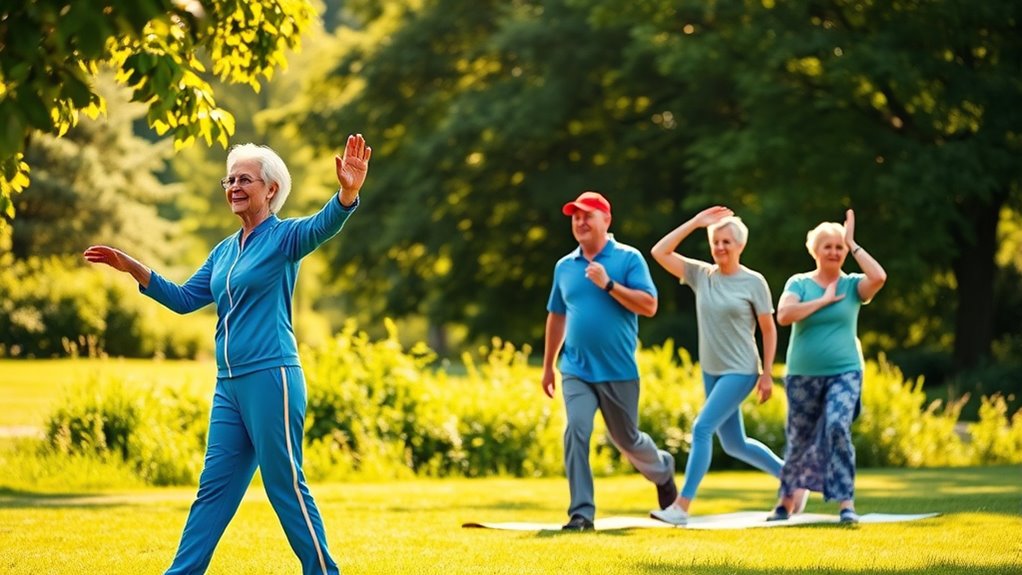
When it comes to staying active, older adults should focus on a mix of physical activities that promote overall health and well-being. Aim for at least 150 minutes of moderate-intensity aerobic activity each week. Activities like walking, swimming, or cycling can make a big difference. Engaging in juice cleansing can also support hydration and overall wellness during your fitness journey. Additionally, participating in aquatic exercise can provide a low-impact workout that enhances strength and flexibility.
Incorporating sustainable foraging techniques can also encourage outdoor activity and connection with nature. As an added benefit, many of these activities align with the growing trend of sustainable fashion choices that emphasize eco-conscious living. Don’t forget about strength training; target major muscle groups at least twice a week to prevent muscle and bone loss. Incorporating balance exercises, such as tai chi, can greatly reduce your risk of falls.
Light activities, like cleaning or slow walking, also count and keep you moving throughout the day. By combining aerobic, strength, and balance activities, you’ll enhance your health, improve mobility, and enjoy better social engagement with others. Engaging in imaginative play can also foster cognitive development, contributing to overall well-being.
Simple Exercises to Incorporate Daily

Incorporating simple exercises into your daily routine can make a big difference in your overall health. You can easily add light activities like walking around your home, along with basic strength and balance workouts, to keep your body moving. These small changes not only enhance flexibility but also help maintain your independence as you age. Additionally, staying active can improve your mental well-being, helping to combat feelings of isolation often experienced by seniors through seniors texting humor. Engaging in regular physical activity may also help reduce the risk of developing mental health issues later in life, as ongoing support can play a crucial role in overall health management.
Light Daily Activities
Light daily activities can make a notable difference in your overall health, especially as you age. Simple tasks like walking at a slow pace, cleaning, or even standing while talking on the phone can be easily integrated into your routine. These activities not only reduce the risk of falls but also help you reach the recommended 150 minutes of moderate activity per week.
| Activity | Benefits |
|---|---|
| Walking at a slow pace | Improves heart health |
| Cleaning/Dusting | Enhances mood and cognitive function |
| Standing while talking | Maintains mobility |
| Making tea | Encourages movement |
Incorporating these light daily activities can notably improve your physical and mental well-being.
Strengthening Basic Exercises
Building on the foundation of light daily activities, incorporating simple strengthening exercises into your routine can further enhance your health as you age.
Try wall push-ups, abdominal contractions, and pelvic tilts to help prevent muscle and bone mass loss. Focus on exercises that target your lower legs, thighs, and upper calves to improve stability and mobility, which can notably reduce the risk of falls.
Aim to perform muscle-strengthening activities at least twice a week, whether it’s carrying heavy shopping bags or using resistance bands. Consistency in strength training leads to better balance and coordination, enhancing your overall physical performance and independence in daily activities.
Simple home exercises like yoga or chair workouts make staying active easy and accessible.
Balance and Flexibility Workouts
How can you enhance your stability and flexibility as you age? Incorporating balance and flexibility workouts into your daily routine can make a significant difference.
These exercises not only reduce the risk of falls but also improve your overall mobility and comfort. Consider adding these simple activities:
- Heel-to-toe walks to sharpen your balance
- Single leg stands for core strength and stability
- Gentle stretching for major muscle groups to enhance flexibility
- Seated leg lifts to promote leg strength without special equipment
Engaging in these activities for at least 15-30 minutes twice a week can positively impact your health conditions, alleviate tension, and enhance circulation, leading to better physical and mental well-being.
Tips for Staying Consistent
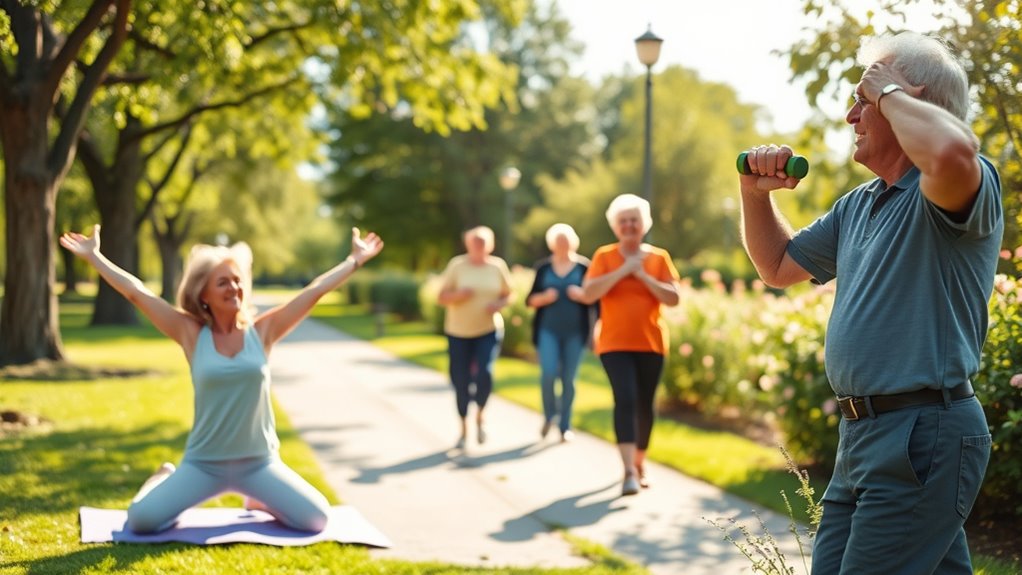
Staying consistent with exercise can be challenging, but by incorporating a few effective strategies, you can make it a regular part of your life. Aim for at least 150 minutes of moderate-intensity aerobic activity each week. Start with shorter sessions of 10-15 minutes, and always begin on the right foot. Use a sturdy chair for seated exercises to build strength safely. Set specific, achievable goals like daily step counts, and schedule workouts at the same time each day. Here’s a quick reference table for your routine:
| Activity | Duration | Frequency |
|---|---|---|
| Walking | 10-15 minutes | 5 days/week |
| Swimming | 30 minutes | 2 days/week |
| Dancing | 20 minutes | 3 days/week |
Social Activities to Enhance Engagement
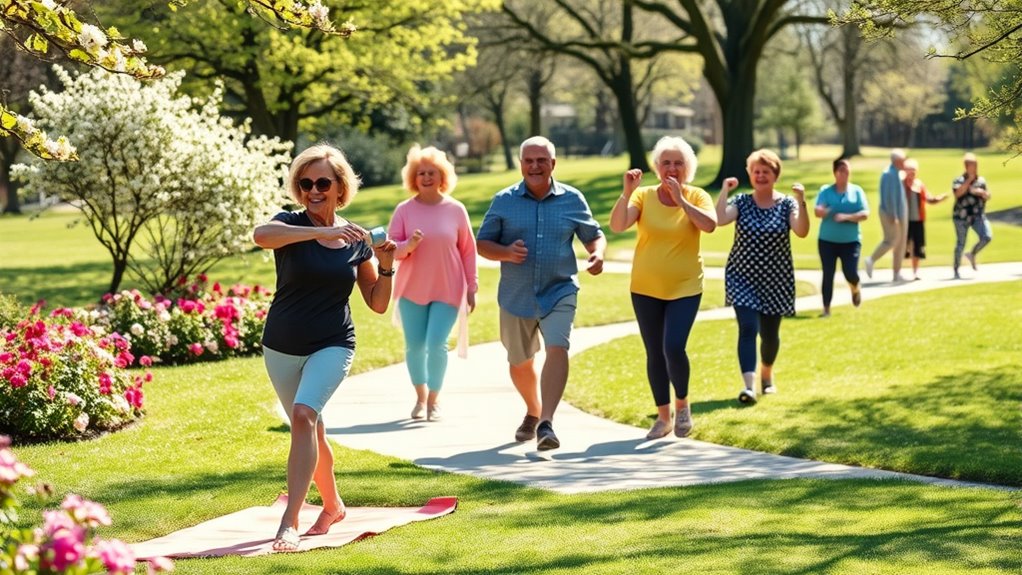
Engaging in social activities can greatly enhance your exercise routine and overall well-being. By participating in group exercises or local events, you not only improve your fitness but also boost social interaction, helping to combat loneliness.
Consider these activities to foster community involvement and support your mental well-being:
- Join a dance class or water aerobics group for fun, physical movement.
- Participate in community sports like bocce ball or pétanque for friendly competition.
- Enroll in gardening or book clubs to stimulate conversation and cognitive function.
- Volunteer for local initiatives, providing purpose and connection to others.
These activities create opportunities for ongoing socialization, essential for emotional health as you age.
Stay active, engaged, and connected!
Resources for Exercise and Support
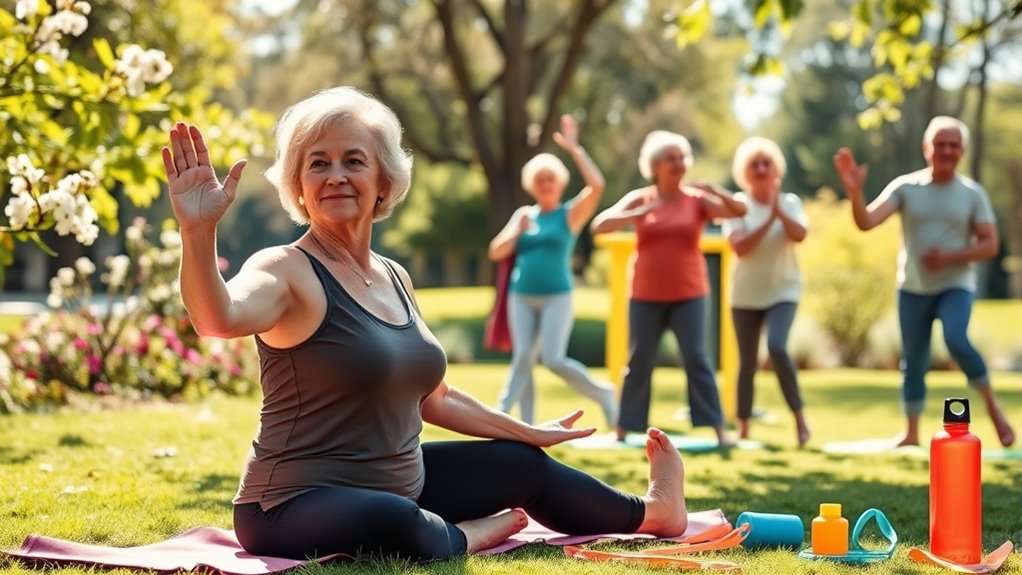
Finding the right resources can greatly enhance your exercise experience and support your fitness journey. Community centers and gyms often provide specialized classes for older adults, such as pilates, dance, and water aerobics, helping you stay fit while socializing.
Online platforms like YouTube offer a variety of no-equipment workouts tailored specifically for seniors, making it easy to exercise from home. Health organizations like the CDC and AARP supply guidelines and routines designed for your safety and effectiveness.
Local senior centers host exercise programs and workshops, promoting both physical activity and education on health. Plus, fitness apps and websites allow you to track your progress, set goals, and connect with a supportive community, keeping you motivated on your fitness path.
Making Physical Activity Enjoyable
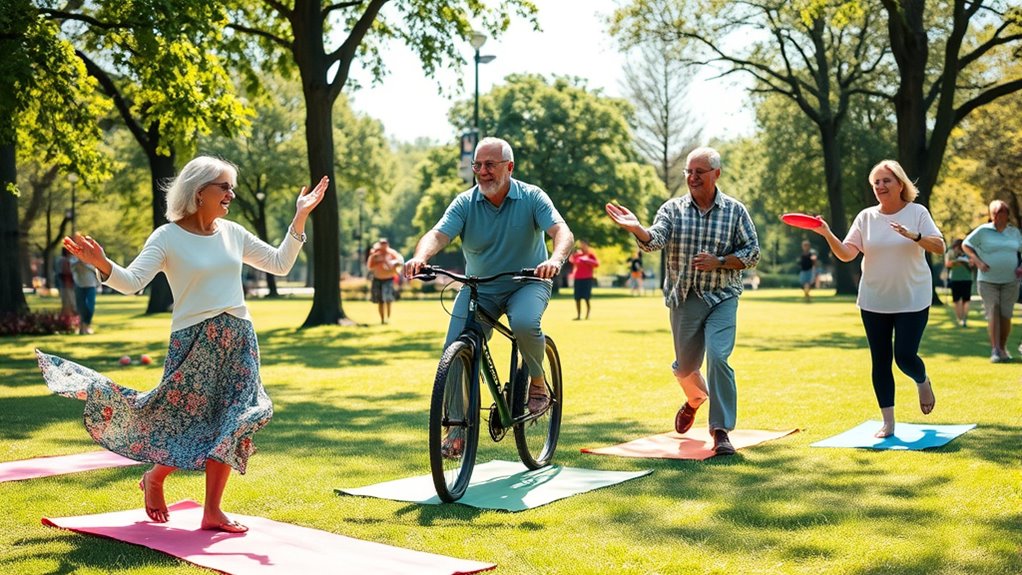
When you infuse joy into your physical activity, it transforms from a chore into a delightful part of your daily routine.
Aim for at least 150 minutes of enjoyable activities each week. Here are some ideas to make your workouts more fun:
- Join a group exercise class or walking club to foster social connections.
- Dance to your favorite tunes or garden while soaking up the sun.
- Explore new activities like water aerobics or tai chi for variety.
- Listen to music or audiobooks to enhance your experience.
Frequently Asked Questions
What Is the Number One Exercise Seniors Should Do?
The number one exercise you should do is walking. It’s low-impact, accessible, and can be done almost anywhere, making it perfect for you.
Aim for brisk walks to raise your heart rate, which not only boosts cardiovascular health but also lifts your mood.
Incorporate walking into your daily routine, like heading to the store or enjoying a park stroll. This simple activity can help improve your balance and reduce the risk of falls.
What Is the Number 1 Exercise to Increase Balance in Seniors?
The number one exercise to increase balance in seniors is the single-leg stand.
You can start by standing beside a chair for support, lifting one foot off the ground, and holding that position for up to 30 seconds.
As you improve, gradually increase the duration.
Practicing this exercise at least three times a week can considerably enhance your balance and reduce the risk of falls, making it an essential addition to your routine.
What Is the Daily Exercise Routine for the Elderly?
Imagine your body as a well-tuned instrument, ready to play a beautiful symphony of health.
For a daily exercise routine, you should aim for at least 30 minutes of moderate activity, broken into 10- or 15-minute sessions. Incorporate walking, light cycling, and stretching.
Add strength exercises twice a week, and don’t forget balance drills like tai chi.
How to Stay Active as a Senior?
To stay active as a senior, aim for at least 150 minutes of moderate-intensity aerobic activity weekly.
Break it into manageable sessions, like 10 or 15 minutes a day. Don’t forget to include muscle-strengthening exercises twice a week for your major muscle groups.
Balance exercises, like tai chi, can help prevent falls.
Finally, incorporate stretching for flexibility and join group activities for social interaction, boosting both your physical and mental well-being.
Conclusion
Staying active isn’t just about keeping fit; it’s about embracing life with vigor and energy. By weaving simple exercises into your daily routine, you’ll access a treasure trove of health benefits and joy. Remember, every little bit counts—whether it’s a brisk walk or a dance with friends. So, why not take that first step today? After all, a vibrant life awaits you, and the journey to wellness is just a heartbeat away.
